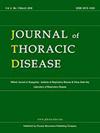摘要
背景:微创胸腔手术是肺切除术中最常用的方法,可最大限度地减轻手术对患者的压力。为了进一步降低侵入性,麻醉侧采用了不插管自发通气法。然而,由于这种方法会导致气道不安全,因此并未被广泛采用。本研究分析了我们采用双腔管插管自发通气法和单门户视频辅助胸腔手术(VATS)肺叶切除术的手术效果:2015年至2023年间,302名患者根据麻醉类型在两个不同时期接受了单孔VATS肺叶切除术。2015 年至 2019 年期间,210 名患者(93 名男性,117 名女性,平均年龄 64.3 岁)(GA-VATS 组)采用传统放松、双腔管插管和机械单肺通气全身麻醉(GA)进行了肺叶切除术。2021 年至 2023 年期间,92 例患者(男性 44 例,女性 48 例,平均年龄 66.3 岁)在经过短暂放松期、双腔插管和迷走神经阻滞后接受了自发通气的肺叶切除术(SVI-VATS 组)。经过 1:1 样本倾向得分匹配(卡尺 0.1)后,对每组 66 名患者的围手术期数据进行了分析:就所有患者而言,GA-VATS 组和 SVI-VATS 组的死亡率和发病率分别为 1(0.47%)和 0(0%),以及 52(24.7%)(P=0.050)和 19(20.6%)(P=0.32)。GA-VATS组的IIIB级并发症发生率为13(6.1%),SVI-VATS组为0(0%)(P=0.01)。手术时间为 91.1 分钟 vs. 86.4 分钟(P=0.10),胸腔引流时间为 4.64±4.58 天 vs. 3.39±3.39 天(P=0.02),永久性漏气率为 43(20.4%) vs. 8(8.7%)(P=0.001),GA-VATS组和SVI-VATS组的再手术率分别为11(5.2%) vs. 0(0%)(P=0.02),切除纵隔淋巴结数分别为12.7 vs. 12.7(P=0.97)。经过倾向评分匹配分析,两组均无死亡病例。发病率分别为 19 例(28.8%)和 15 例(22.7%)(P=0.55),手术时间分别为 99 分钟和 86.7 分钟(P=0.003),胸腔引流时间分别为 5.1 天和 3.8 天(P=0.02),GA-VATS组和SVI-VATS组的永久性漏气率分别为15(22.7%)对8(12.1%)(P=0.10),再手术率分别为5(7.57%)对0(0%)(P=0.058):与GA-VATS相比,SVI-VATS肺叶切除术的并发症较少,尤其是需要在麻醉下矫正的并发症(IIIb),术后时间也较短。两组切除的纵隔淋巴结数量相似。Background: Minimally invasive thoracic surgery is the most frequently used approach for lung resection to minimize surgical stress on the patient. To further reduce invasiveness, the non-intubated spontaneous ventilation method is applied on the anesthesia side. However, due to the unsafe airway associated with this procedure, this method is not widely adopted. This study analyzes the surgical results of our method, which involves spontaneous ventilation with double lumen tube intubation and uniportal video-assisted thoracic surgery (VATS) lung lobectomies.
Methods: Between 2015 and 2023, 302 patients underwent uniportal VATS lobectomy in two different periods, depending on the type of anesthesia. Between 2015 and 2019, traditional relaxation, double lumen tube intubation, and general anesthesia (GA) with mechanical one-lung ventilation were used for lobectomies in 210 patients (93 males, 117 females, mean age 64.3 years) (GA-VATS group). Between 2021 and 2023, 92 cases (44 males, 48 females, mean age 66.3 years) underwent lobectomy with spontaneous ventilation after a short relaxation period, double lumen intubation, and vagus nerve blockade (SVI-VATS group). Perioperative data from 66 patients in each group were analyzed after 1:1 sample propensity score matching (caliper 0.1).
Results: Respecting all patients, in the GA-VATS and SVI-VATS groups, the mortality and morbidity rates were 1 (0.47%) and 0 (0%), and 52 (24.7%) (P=0.050) and 19 (20.6%) (P=0.32), respectively. The rate of grade IIIB complications was 13 (6.1%) in the GA-VATS group and 0 (0%) in the SVI-VATS group (P=0.01). The length of surgery was 91.1 vs. 86.4 min (P=0.10), duration of chest drainage was 4.64±4.58 vs. 3.39±3.39 days (P=0.02), the rate of permanent air leak was 43 (20.4%) vs. 8 (8.7%) (P=0.001), reoperation rate was 11 (5.2%) vs. 0 (0%) (P=0.02), and the number of removed mediastinal lymph nodes was 12.7 vs. 12.7 (P=0.97) in the GA-VATS and SVI-VATS groups, respectively. After propensity score-matched analysis, there were no cases of mortality in either group. Morbidity rates were 19 (28.8%) and 15 (22.7%) (P=0.55), length of surgery was 99 vs. 86.7 min (P=0.003), duration of chest drainage was 5.1 vs. 3.8 days (P=0.02), the rate of permanent air leak was 15 (22.7%) vs. 8 (12.1%) (P=0.10), and the reoperation rate was 5 (7.57%) vs. 0 (0%) (P=0.058) in the GA-VATS and SVI-VATS groups, respectively.
Conclusions: SVI-VATS lobectomy resulted in fewer complications, particularly those requiring correction under anesthesia (IIIb) and a shorter postoperative period than GA-VATS. The number of removed mediastinal lymph nodes was similar between the groups.

 求助内容:
求助内容: 应助结果提醒方式:
应助结果提醒方式:


